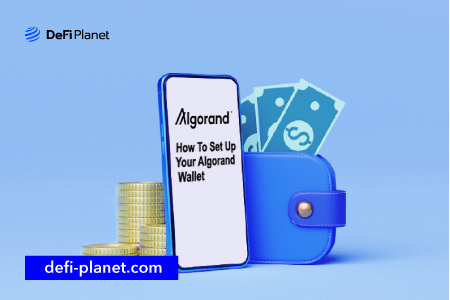Last updated on November 16th, 2022 at 11:58 am
Algorand has long been known as one of the most innovative projects in the crypto ecosystem. Founded in 2017 by Silvio Micali, a computer scientist, and Massachusetts Institute of Technology (MIT) professor, Algorand is lauded for introducing the novel Pure Proof-of-Stake blockchain that attempts to solve the blockchain trilemma using algorithmic randomness.
With $ALGO’s price almost doubling in recent months, more and more people have started paying attention to the Algorand ecosystem in addition to its native token. In order to start interacting with the Algorand ecosystem, the first step is to set up a digital wallet that is compatible with the blockchain. While users have different wallet options available to them, one of the best digital wallets to explore the Algorand ecosystem is its official Alogrand wallet.
This article will talk about the Alogrand Wallet, its key features, and how you can set up your wallet and interact with the Alogrand ecosystem.
Let’s dive in!
What Is The Algorand Wallet?
To transact with the Alogrand blockchain in a quick and secure manner, the team behind Algorand introduced the official Algorand Wallet. The best part about the wallet is that it is created and maintained by the expert team of professionals that actively maintain the Algorand protocol. As a result, any updates or integrations that take place on the Algorand blockchain always come first to the Algorand Wallet, and thus, users are able to enjoy the latest features at any given time.
Here are some benefits and features of using the Alogrand wallet:
- Transact on the Algorand blockchain – The Algorand wallet is compatible with Algo and all Algorand Standard Assets (ASAs). Thus, users can use the wallet to send, receive, or HODL any crypto that they might need to operate in the Algorand ecosystem.

- Real-time fiat conversion mechanism – The Alogrand wallet allows users to see what their Algo native crypto holdings are worth in any currency in real-time.
- Earn Algo rewards – Algorand wallet users can earn Algo rewards simply by holding Algos in their wallets.
- Ledger Nano Integration – Users can pair their Algorand wallet with the Ledger Nano X and make their wallets more secure.

- BUIDL with the Algorand Wallet – Developers can connect to the TestNet and use the built-in support to test out different applications, assets, and smart contracts on the Algorand blockchain
How To Set Up Your Alogrand Wallet
To create an account and transact on the Algorand blockchain, users need to set up an Algorand wallet. To do so, one must follow the given steps:
- Step 1 – Install the app on Android or IOS.

- Step 2 – After installing and opening the app for the first time, users will need to create a 6-digital passcode for their wallet. Moreover, they also have the option of enabling a biometric login such as FaceID or FingerprintID. This passcode acts as a security barrier that prevents anyone from entering the wallet without the users’ knowledge.

By following these two steps, users can complete the initial setup of the Algorand wallet. After this, the users need to create an account on the wallet. Within the wallet, users can establish as many Algorand accounts as they like, but each account has its own backup (recovery) pass.
- The address – The address is a one-of-a-kind string that is used to identify your account publicly. This is the method by which users will send assets to their accounts. This is how the address will appear – RL6VDLXCN5G7N2GRTS7YLVDSFT4PVBBUOVTVS7T26OQ5MLXYQKRMI5ADXY
- Recovery phase – The recovery pass also known as the backup phrase or recovery phrase is a 25-word string that enables users to regain access to their accounts. It’s critical that you record your backup phrase correctly and keep it safe. This backup phrase is the sole way to recover an Algorand account.
- Assets – Algos and other Algorand Standard Assets (ASAs) like USDT, USDC, and others will be among the assets that can be stored on the wallet.
To create an account, follow the steps below:
- Step 1 – On the account view page, tap the green + icon at the top right of the screen.

- Step 2 – To create a new account on the wallet, tap add account.

It’s worth noting that users may be entering this process just after setting up their Algorand Wallet, or they may be generating new accounts. Regardless, the procedure remains the same.
- Step 3 – Tap create account to begin the process.

- Step 4 – Here, users are shown an account creation overview screen. It’s vital that users review the section thoroughly and understand the key details of setting up an account. Once they’ve reviewed the information, they can press “I understand” to proceed.

- Step 5 – At this step, users will be asked to prepare for writing down the recovery phase. This phase is the only way back into the account thus it’s important to write it down and store it securely. Once you’re ready to write down the phase, tap “I’m ready to begin”.

- Step 6 – Note down the 25-word recovery passphrase. It’s important to note that the app does not allow users to take a screenshot of this screen. Thus, it’s vital that you find a method to store it securely.
- Step 7 – To ensure that users have recorded the passphrase successfully, they will be asked to select a few random keywords in the phrase.

- Step 8 – Name your account to finish the account creation process.

If you have followed the steps correctly, you should now be able to see the newly created account in the Accounts view screen on the Alogrand Wallet.
In Conclusion…
- The Alogrand ecosystem is growing in terms of adoption and this is only the beginning. As more DApps launch on the Algorand blockchain, more users will flock to the ecosystem. To interact with the blockchain, every user will need a wallet that is compatible with the Algorand blockchain and the official Algorand wallet is one of the best options available.
So, what do you think about the Algorand protocol? Do you think the Algorand wallet offers a secure and quick way to interact with the Algorand ecosystem?
Comment below and let us know what you think!
If you would like to read more articles like this, follow DeFi Planet on Twitter and LinkedIn.





















